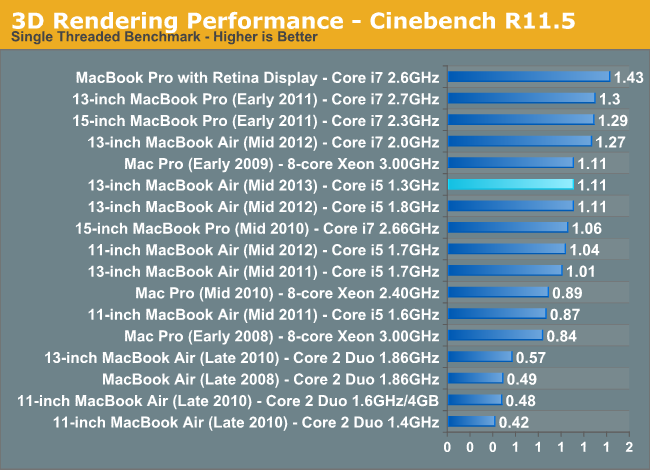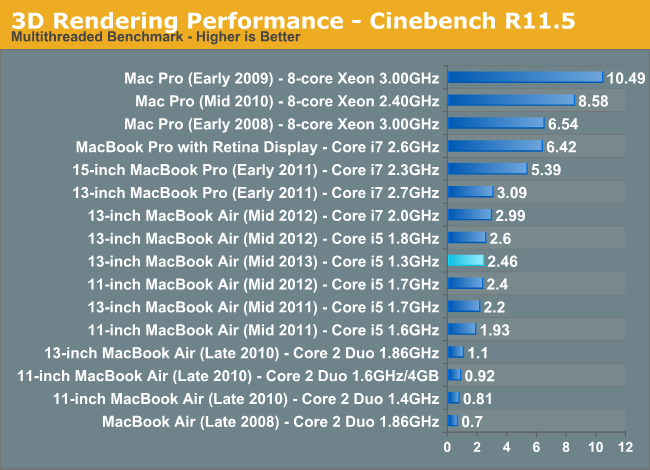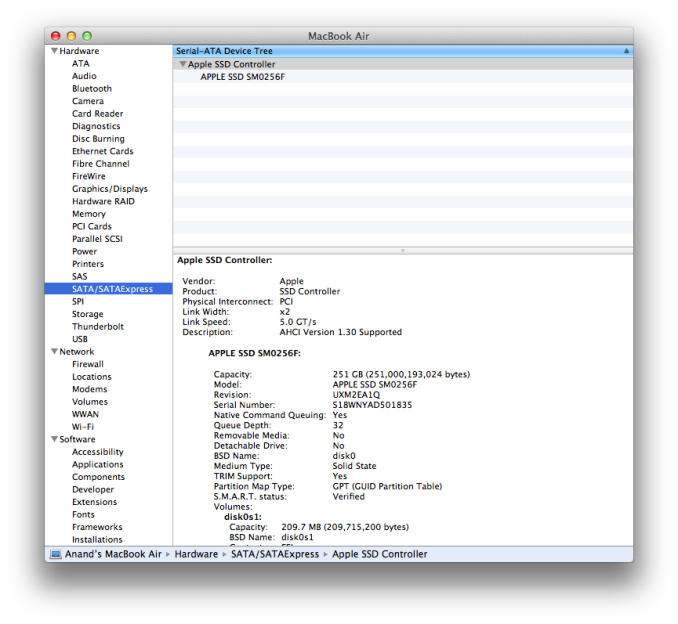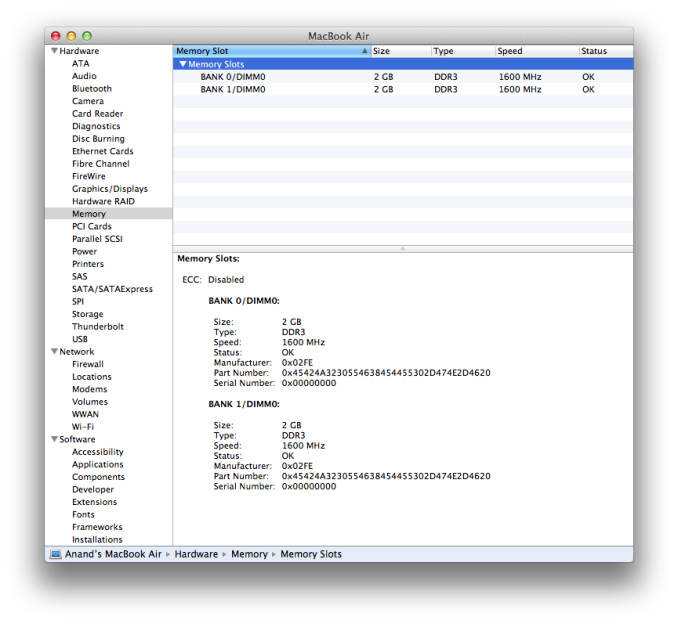2013 MacBook Air: PCIe SSD and Haswell ULT Inside
by Anand Lal Shimpi on June 10, 2013 10:01 PM EST- Posted in
- Mac
- Storage
- SSDs
- Apple
- MacBook Air

This morning Apple updated its MacBook Air to Intel's Haswell ULT silicon. The chassis itself didn't get any updates, nor did the displays. Both the 11 and 13 inch models retain their non-Retina 1366 x 768 and 1440 x 900 displays. There's a slight increase in battery capacity. The 11-inch model moves to 38Wh (8.6%) while the 13-inch model goes to 54.4Wh (8.8%). The big changes however are on the CPU, NAND and DRAM fronts.
With the new MacBook Air, Apple moves to a Core i5-4250U. The base clock drops to 1.3GHz across all of the models, but max turbo remains at 2.6GHz. Although the base clock is lower, I wouldn't expect substantially lower performance since the max turbo is unchanged as is the chassis that has to dissipate the thermals. To confirm, I ran a couple of Cinebench tests and generally found performance similar to that of last year's models:


The 1.8GHz i5 in the 13-inch ended up being a bit quicker than the 1.3GHz 4250U this generation in the multithreaded test, but in single threaded performance the two are equal. The impact on the MT test is about 5%, it's there but not substantial. Don't be fooled by base clock, it's the combination of base clock, max turbo and cooling solution that'll determine performance here. As we found in our Haswell ULT review, CPU performance isn't something you can expect to see more of with Haswell vs. Ivy Bridge in these low wattage platforms.
You can get a 1.7GHz Core i7 upgrade with a 3.3GHz max turbo (i7-4650U). Both parts have Intel GT3 graphics clocked at a max of 1GHz on the i5 and 1.1GHz on the i7. Since the max GPU clocks are south of 1.2GHz, this is officially Intel's HD 5000 graphics and not Iris despite using the same silicon. The GPU base clock drops from 350MHz down to 200MHz, which should help reduce idle power consumption.
| 2013 MacBook Air Lineup | ||||||
| 11.6-inch | 11.6-inch (high-end) | 13.3-inch | 13.3-inch (high-end) | |||
| Dimensions |
H: 0.11-0.68" (0.3-1.7cm) W: 11.8" (30cm) D: 7.56" (19.2cm) |
H: 0.11-0.68" (0.3-1.7cm) W: 12.8" (32.5cm) D: 8.94" (22.7cm) |
||||
| Weight | 2.38 lbs (1.08kg) | 2.96 lbs (1.35kg) | ||||
| CPU | 1.3GHz dual-core Core i5 | 1.3GHz dual-core Core i5 | ||||
| GPU | Intel HD 5000 | |||||
| RAM | 4GB LPDDR3-1600 | |||||
| SSD | 128GB PCIe SSD | 256GB PCIe SSD | 128GB PCIe SSD | 256GB PCIe SSD | ||
| Display Resolution | 1366 x 768 | 1440 x 900 | ||||
| Ports | Thunderbolt, 2x USB 3.0, headphone jack | Thunderbolt, 2x USB 3.0, SD card slot, headphone jack | ||||
| Price | $999 | $1199 | $1099 |
$1299 |
||
On the storage front, Apple officially leads the charge with the move to PCIe based SSDs. The upcoming Mac Pro, as well as the new MacBook Airs both use PCIe based SSDs instead of SATA drives. A quick look at OS X's system profiler reveals a PCIe 2.0 x2 interface, capable of 1GB/s in each direction.
The drive in my system uses a Samsung controller, although I've heard that SanDisk will have a PCIe solution for Apple as well. A quick run through Quick Bench reveals peak sequential read/write performance of nearly 800MB/s:
This is a pretty big deal, as it is probably the first step towards PCIe storage in a mainstream consumer device that we've seen. I'm still awaiting official confirmation as to whether or not this is an M.2 based solution or a proprietary connector. Update: It's a custom Apple design, not M.2. Since there's no PCIe routed off of the CPU in Haswell ULT, these 2 lanes come from the on-package PCH.
The other big change is the move from DDR3L to LPDDR3, a new feature supported by Haswell ULT. I need to go back and dig through the Haswell ULT datasheets again, but I believe the total memory interface width remains at 128-bits wide even if you use LPDDR3 - you just get lower power consumption.
Obviously battery life is the biggest improvement here with the new MacBook Air. Thanks to Haswell's platform power optimizations, Apple claims up to 12 hours on a single charge for the 2013 13-inch MacBook Air. Given the improvements I saw in our Haswell ULT review, I don't doubt that we could see some very good numbers out of these notebooks.
I just got my hands on a 13-inch 2013 MBA and I'll be running performance tests (including the first look at Intel's HD 5000 graphics) over the coming days. I'm still traveling until Thursday but I'll do my best to run battery life tests while I'm on the road as well. More soon!













174 Comments
View All Comments
mavere - Monday, June 10, 2013 - link
Is it safe to regard the Samsung SSD as a refitted 840 Pro? Or does Apple usually customize the firmware?darwinosx - Monday, June 10, 2013 - link
Not remotely an 840 Pro. Totally different design, bus, and much faster.Death666Angel - Tuesday, June 11, 2013 - link
Faster likely because of the different interface. Different design is a given since it uses a different interface. But how do you know that it is totally different and not just adapted to the specific needs of the different interface?DERSS - Wednesday, June 12, 2013 - link
Apple does not use Samsung (or anyone else's) SSDs in any of its products, they design their own SSDs.That said, the controller here for MBA is by Samsung (or it could be another supplier). Though patented solutions that this controller works on are Apple's; their engineers invented the technology (Apple bought its developers couple of years ago).
Dug - Wednesday, June 12, 2013 - link
Where did you get your info?http://www.anandtech.com/show/6727/apple-is-using-...
descendency - Monday, June 10, 2013 - link
Second to last paragraph: "Obviously battery life is the biggest improvement here with the new MacBook Pro."I think it should say MacBook Air. (there was no new Pro announced)
JamesL - Monday, June 10, 2013 - link
Excuse my ignorance, but what is the difference between mass storage via SATA and PCI-E? Doesn't SATA typically run over a PCI-E bus and if so, what is the purpose of SATA?mevans336 - Monday, June 10, 2013 - link
SATA is limited by the SATA spec. In the case of SATA-III, that's about 500MB/s. By eliminating the SATA spec and running raw PCIe, you eliminate a bottleneck and can achieve much higher throughput. I'm not an computer engineer, but as I understand it, SATA would be similar to tunneling a higher-level network protocol through a lower level one. By eliminating the higher-level protocol (SATA) and moving to transport using the lower level protocol (PCIe) you can achieve much higher throughput.fteoath64 - Tuesday, June 11, 2013 - link
Great explanation Mevan!. You are right, eliminating hardcoded sata controller allows for faster throughput and less overhead in signalling, many of which were for HDD and useless of SSD. Old scheme is [SSD Ctrl/firmware: sata port]---sata cable---host-sata-port---PCIbus or PCIe lane {ahci driver in OS}.New PCIe scheme is [SSD Ctrl/ PCIe port/chip---edgeconnector---PCIe-lane connector {ahci driver}. Short cut is good!.
vol7ron - Tuesday, June 11, 2013 - link
Worth mentioning that until recently, SSDs couldn't really come near that threshold. Also worth mentioning, those that do are only saturating it with sequential reads/writes. Finally, worth mentioning that the typical user most likely won't have a need for it. Unless you've lots of $$, large data transfers generally require large data storage, which are most likely going to be HDD or hybrid drives; though TB SSDs will be commonplace soon.